Management and Operations
VerifiedAdded on 2023/01/18
|16
|4943
|78
AI Summary
This document discusses the role of management and leadership in business organizations, with a focus on Airdri organization. It explores the different approaches to leadership and their strengths and weaknesses. It also discusses the application of chaos theory and management by objective to Airdri organization.
Contribute Materials
Your contribution can guide someone’s learning journey. Share your
documents today.
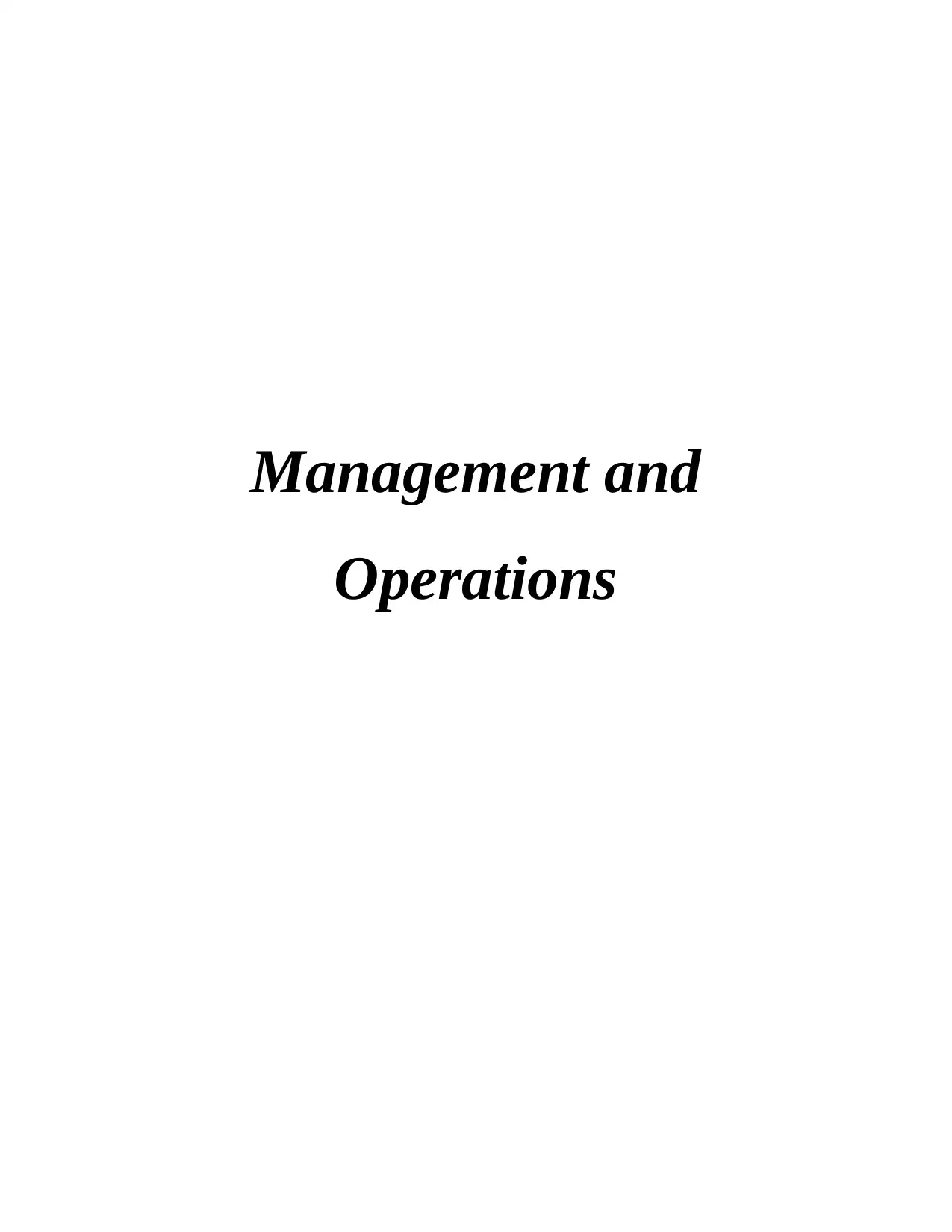
Management and
Operations
Operations
Secure Best Marks with AI Grader
Need help grading? Try our AI Grader for instant feedback on your assignments.
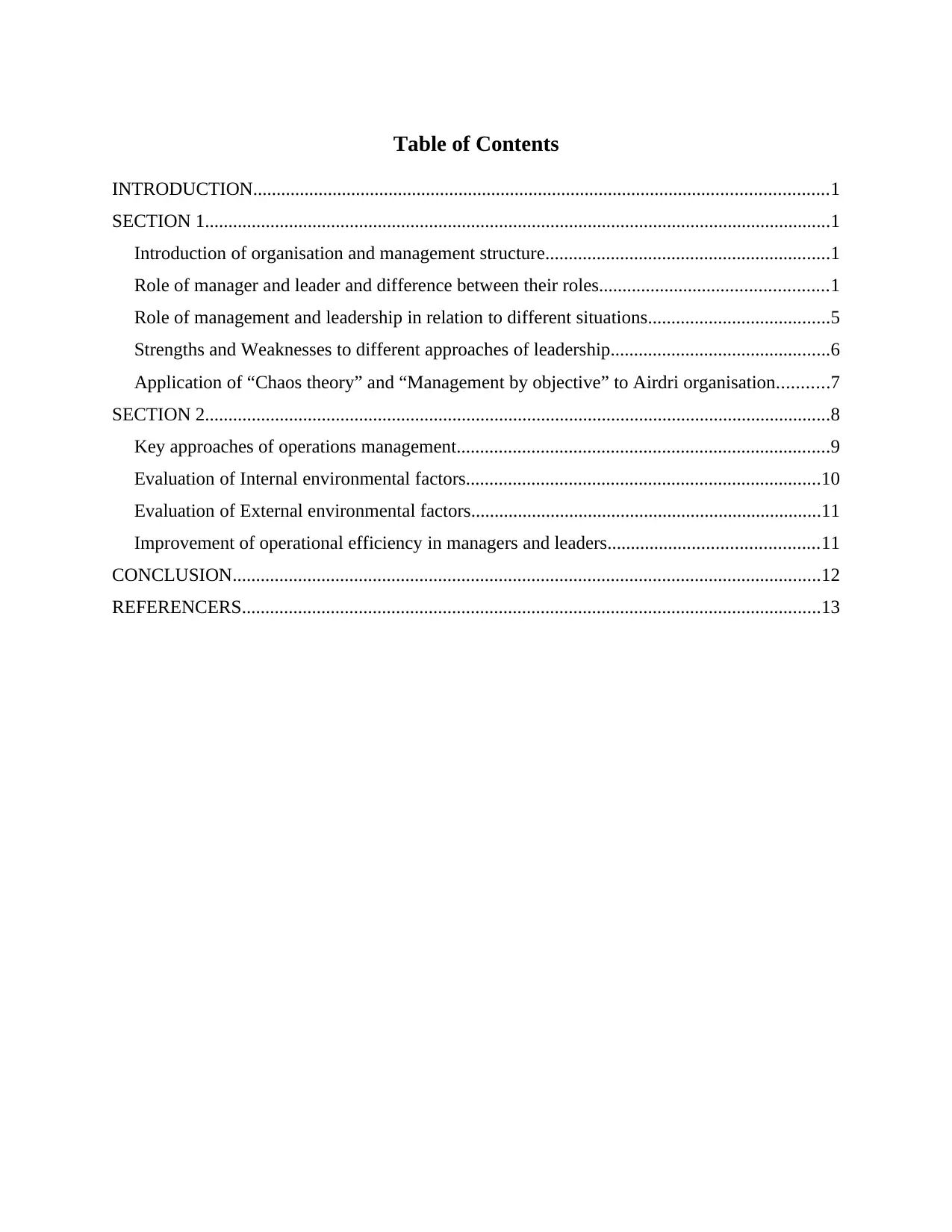
Table of Contents
INTRODUCTION...........................................................................................................................1
SECTION 1......................................................................................................................................1
Introduction of organisation and management structure.............................................................1
Role of manager and leader and difference between their roles.................................................1
Role of management and leadership in relation to different situations.......................................5
Strengths and Weaknesses to different approaches of leadership...............................................6
Application of “Chaos theory” and “Management by objective” to Airdri organisation...........7
SECTION 2......................................................................................................................................8
Key approaches of operations management................................................................................9
Evaluation of Internal environmental factors............................................................................10
Evaluation of External environmental factors...........................................................................11
Improvement of operational efficiency in managers and leaders.............................................11
CONCLUSION..............................................................................................................................12
REFERENCERS............................................................................................................................13
INTRODUCTION...........................................................................................................................1
SECTION 1......................................................................................................................................1
Introduction of organisation and management structure.............................................................1
Role of manager and leader and difference between their roles.................................................1
Role of management and leadership in relation to different situations.......................................5
Strengths and Weaknesses to different approaches of leadership...............................................6
Application of “Chaos theory” and “Management by objective” to Airdri organisation...........7
SECTION 2......................................................................................................................................8
Key approaches of operations management................................................................................9
Evaluation of Internal environmental factors............................................................................10
Evaluation of External environmental factors...........................................................................11
Improvement of operational efficiency in managers and leaders.............................................11
CONCLUSION..............................................................................................................................12
REFERENCERS............................................................................................................................13
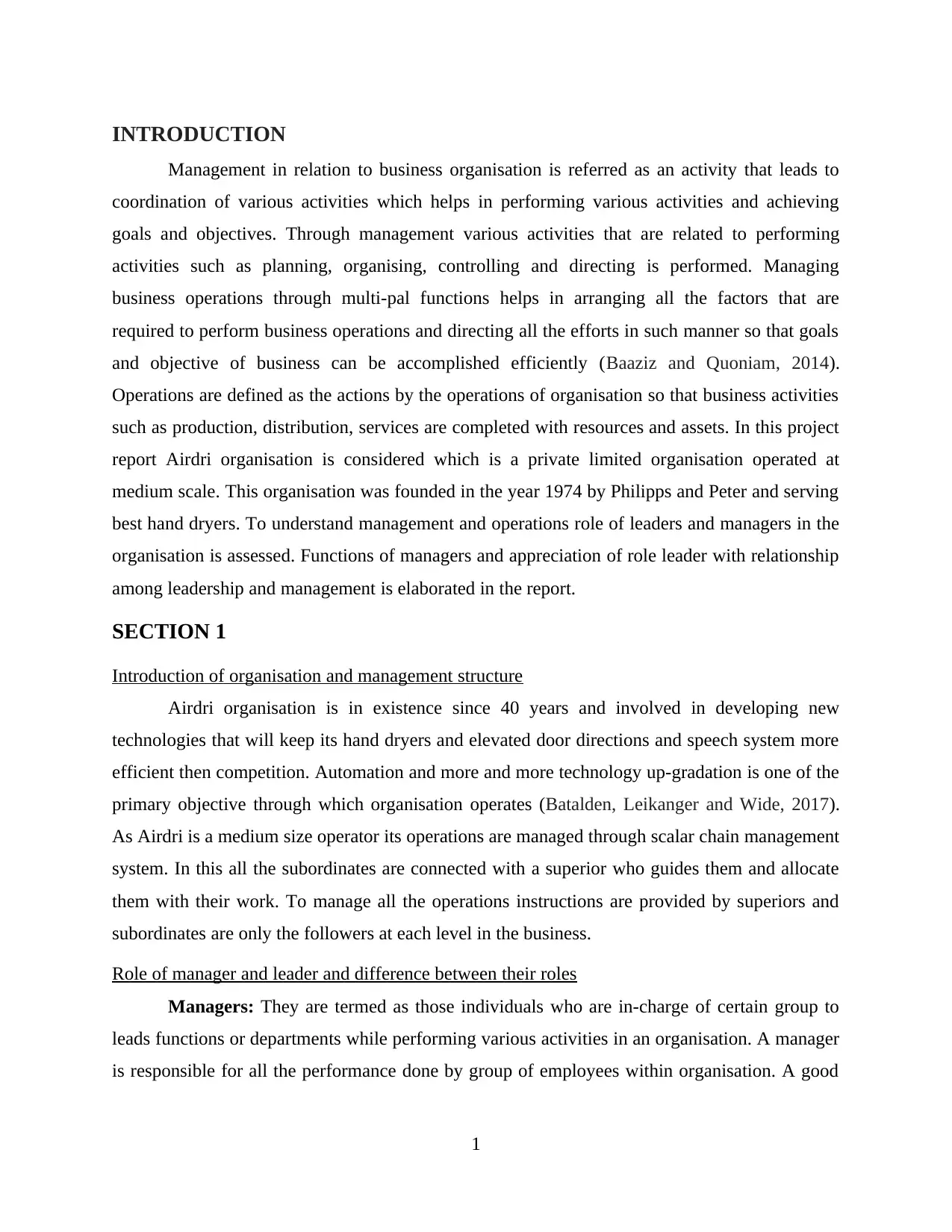
INTRODUCTION
Management in relation to business organisation is referred as an activity that leads to
coordination of various activities which helps in performing various activities and achieving
goals and objectives. Through management various activities that are related to performing
activities such as planning, organising, controlling and directing is performed. Managing
business operations through multi-pal functions helps in arranging all the factors that are
required to perform business operations and directing all the efforts in such manner so that goals
and objective of business can be accomplished efficiently (Baaziz and Quoniam, 2014).
Operations are defined as the actions by the operations of organisation so that business activities
such as production, distribution, services are completed with resources and assets. In this project
report Airdri organisation is considered which is a private limited organisation operated at
medium scale. This organisation was founded in the year 1974 by Philipps and Peter and serving
best hand dryers. To understand management and operations role of leaders and managers in the
organisation is assessed. Functions of managers and appreciation of role leader with relationship
among leadership and management is elaborated in the report.
SECTION 1
Introduction of organisation and management structure
Airdri organisation is in existence since 40 years and involved in developing new
technologies that will keep its hand dryers and elevated door directions and speech system more
efficient then competition. Automation and more and more technology up-gradation is one of the
primary objective through which organisation operates (Batalden, Leikanger and Wide, 2017).
As Airdri is a medium size operator its operations are managed through scalar chain management
system. In this all the subordinates are connected with a superior who guides them and allocate
them with their work. To manage all the operations instructions are provided by superiors and
subordinates are only the followers at each level in the business.
Role of manager and leader and difference between their roles
Managers: They are termed as those individuals who are in-charge of certain group to
leads functions or departments while performing various activities in an organisation. A manager
is responsible for all the performance done by group of employees within organisation. A good
1
Management in relation to business organisation is referred as an activity that leads to
coordination of various activities which helps in performing various activities and achieving
goals and objectives. Through management various activities that are related to performing
activities such as planning, organising, controlling and directing is performed. Managing
business operations through multi-pal functions helps in arranging all the factors that are
required to perform business operations and directing all the efforts in such manner so that goals
and objective of business can be accomplished efficiently (Baaziz and Quoniam, 2014).
Operations are defined as the actions by the operations of organisation so that business activities
such as production, distribution, services are completed with resources and assets. In this project
report Airdri organisation is considered which is a private limited organisation operated at
medium scale. This organisation was founded in the year 1974 by Philipps and Peter and serving
best hand dryers. To understand management and operations role of leaders and managers in the
organisation is assessed. Functions of managers and appreciation of role leader with relationship
among leadership and management is elaborated in the report.
SECTION 1
Introduction of organisation and management structure
Airdri organisation is in existence since 40 years and involved in developing new
technologies that will keep its hand dryers and elevated door directions and speech system more
efficient then competition. Automation and more and more technology up-gradation is one of the
primary objective through which organisation operates (Batalden, Leikanger and Wide, 2017).
As Airdri is a medium size operator its operations are managed through scalar chain management
system. In this all the subordinates are connected with a superior who guides them and allocate
them with their work. To manage all the operations instructions are provided by superiors and
subordinates are only the followers at each level in the business.
Role of manager and leader and difference between their roles
Managers: They are termed as those individuals who are in-charge of certain group to
leads functions or departments while performing various activities in an organisation. A manager
is responsible for all the performance done by group of employees within organisation. A good
1
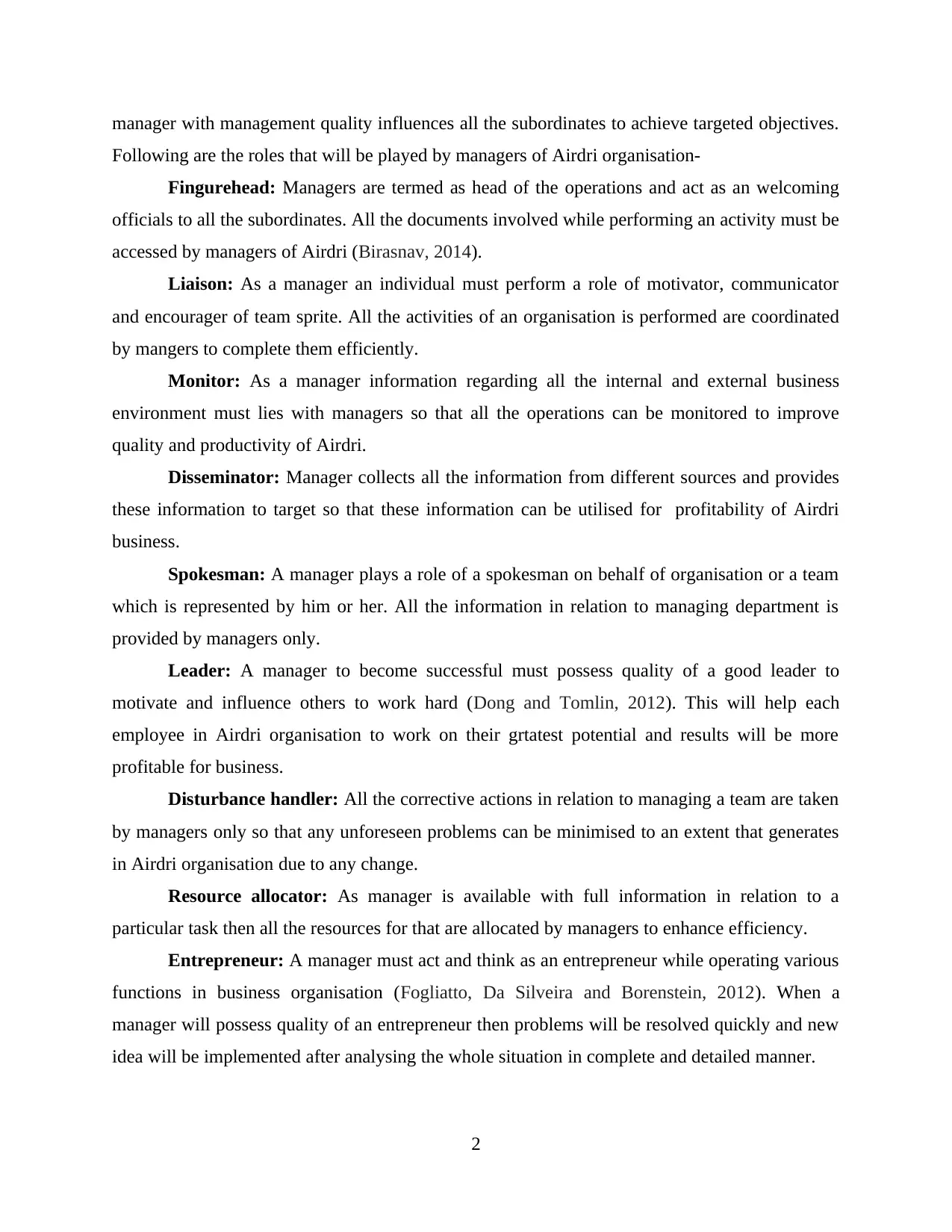
manager with management quality influences all the subordinates to achieve targeted objectives.
Following are the roles that will be played by managers of Airdri organisation-
Fingurehead: Managers are termed as head of the operations and act as an welcoming
officials to all the subordinates. All the documents involved while performing an activity must be
accessed by managers of Airdri (Birasnav, 2014).
Liaison: As a manager an individual must perform a role of motivator, communicator
and encourager of team sprite. All the activities of an organisation is performed are coordinated
by mangers to complete them efficiently.
Monitor: As a manager information regarding all the internal and external business
environment must lies with managers so that all the operations can be monitored to improve
quality and productivity of Airdri.
Disseminator: Manager collects all the information from different sources and provides
these information to target so that these information can be utilised for profitability of Airdri
business.
Spokesman: A manager plays a role of a spokesman on behalf of organisation or a team
which is represented by him or her. All the information in relation to managing department is
provided by managers only.
Leader: A manager to become successful must possess quality of a good leader to
motivate and influence others to work hard (Dong and Tomlin, 2012). This will help each
employee in Airdri organisation to work on their grtatest potential and results will be more
profitable for business.
Disturbance handler: All the corrective actions in relation to managing a team are taken
by managers only so that any unforeseen problems can be minimised to an extent that generates
in Airdri organisation due to any change.
Resource allocator: As manager is available with full information in relation to a
particular task then all the resources for that are allocated by managers to enhance efficiency.
Entrepreneur: A manager must act and think as an entrepreneur while operating various
functions in business organisation (Fogliatto, Da Silveira and Borenstein, 2012). When a
manager will possess quality of an entrepreneur then problems will be resolved quickly and new
idea will be implemented after analysing the whole situation in complete and detailed manner.
2
Following are the roles that will be played by managers of Airdri organisation-
Fingurehead: Managers are termed as head of the operations and act as an welcoming
officials to all the subordinates. All the documents involved while performing an activity must be
accessed by managers of Airdri (Birasnav, 2014).
Liaison: As a manager an individual must perform a role of motivator, communicator
and encourager of team sprite. All the activities of an organisation is performed are coordinated
by mangers to complete them efficiently.
Monitor: As a manager information regarding all the internal and external business
environment must lies with managers so that all the operations can be monitored to improve
quality and productivity of Airdri.
Disseminator: Manager collects all the information from different sources and provides
these information to target so that these information can be utilised for profitability of Airdri
business.
Spokesman: A manager plays a role of a spokesman on behalf of organisation or a team
which is represented by him or her. All the information in relation to managing department is
provided by managers only.
Leader: A manager to become successful must possess quality of a good leader to
motivate and influence others to work hard (Dong and Tomlin, 2012). This will help each
employee in Airdri organisation to work on their grtatest potential and results will be more
profitable for business.
Disturbance handler: All the corrective actions in relation to managing a team are taken
by managers only so that any unforeseen problems can be minimised to an extent that generates
in Airdri organisation due to any change.
Resource allocator: As manager is available with full information in relation to a
particular task then all the resources for that are allocated by managers to enhance efficiency.
Entrepreneur: A manager must act and think as an entrepreneur while operating various
functions in business organisation (Fogliatto, Da Silveira and Borenstein, 2012). When a
manager will possess quality of an entrepreneur then problems will be resolved quickly and new
idea will be implemented after analysing the whole situation in complete and detailed manner.
2
Secure Best Marks with AI Grader
Need help grading? Try our AI Grader for instant feedback on your assignments.

Leaders: A leader is an individual who influences a group of people towards the
achievement of goals and objectives by following all the required strategies. In leaders an ability
to influence others and guide them to become followers is present with clear vision and ability to
make other believes in the idea. While operating various operations in Airdri organisation a
leader needs to accomplish following roles-
Planning: A leader possess all the experience of working in the critical business
environment and to deal with uncertainties in technological development in Airdri a leader is
always needs to be available with contingency plan (Glaser, Stam and Takeuchi, 2016).
Defining: A leader must play role for integrating and defining various activities in the
organisation on the basis through which personal goals of employees are fulfilled with
organisational objectives.
Strategist: A leader must play role of strategist through which goals and objective of
Airdri organisation for introducing high technological goods can be accomplished in planned
manner with multi-pal strategies.
Coach: As a manager an individual who is a leader in the organisation must guide all
their followers so that their internal capabilities are used to achieve their personal and
professional goals in a well defined manner (Goyal, Levi and Segev, 2016).
Motivator: A leader accomplish role of motivator by influencing all the followers in
such manner that their potential is utilised to the fullest and business objective of Airdri is
achieved.
Difference among leader and manager is as follows-
Leader Manager
Leader can be generated through formal
and informal structure in an
organisation.
Leaders motivates team members to
enhance their efficiency and improve
their level of performance.
A leader does not required to be a
manager.
Managers are generated only through a
formal structure.
Manager conducts different functions
of management so that each activity can
be accomplished in desired manner.
To become successful a manager must
be a good leader.
3
achievement of goals and objectives by following all the required strategies. In leaders an ability
to influence others and guide them to become followers is present with clear vision and ability to
make other believes in the idea. While operating various operations in Airdri organisation a
leader needs to accomplish following roles-
Planning: A leader possess all the experience of working in the critical business
environment and to deal with uncertainties in technological development in Airdri a leader is
always needs to be available with contingency plan (Glaser, Stam and Takeuchi, 2016).
Defining: A leader must play role for integrating and defining various activities in the
organisation on the basis through which personal goals of employees are fulfilled with
organisational objectives.
Strategist: A leader must play role of strategist through which goals and objective of
Airdri organisation for introducing high technological goods can be accomplished in planned
manner with multi-pal strategies.
Coach: As a manager an individual who is a leader in the organisation must guide all
their followers so that their internal capabilities are used to achieve their personal and
professional goals in a well defined manner (Goyal, Levi and Segev, 2016).
Motivator: A leader accomplish role of motivator by influencing all the followers in
such manner that their potential is utilised to the fullest and business objective of Airdri is
achieved.
Difference among leader and manager is as follows-
Leader Manager
Leader can be generated through formal
and informal structure in an
organisation.
Leaders motivates team members to
enhance their efficiency and improve
their level of performance.
A leader does not required to be a
manager.
Managers are generated only through a
formal structure.
Manager conducts different functions
of management so that each activity can
be accomplished in desired manner.
To become successful a manager must
be a good leader.
3
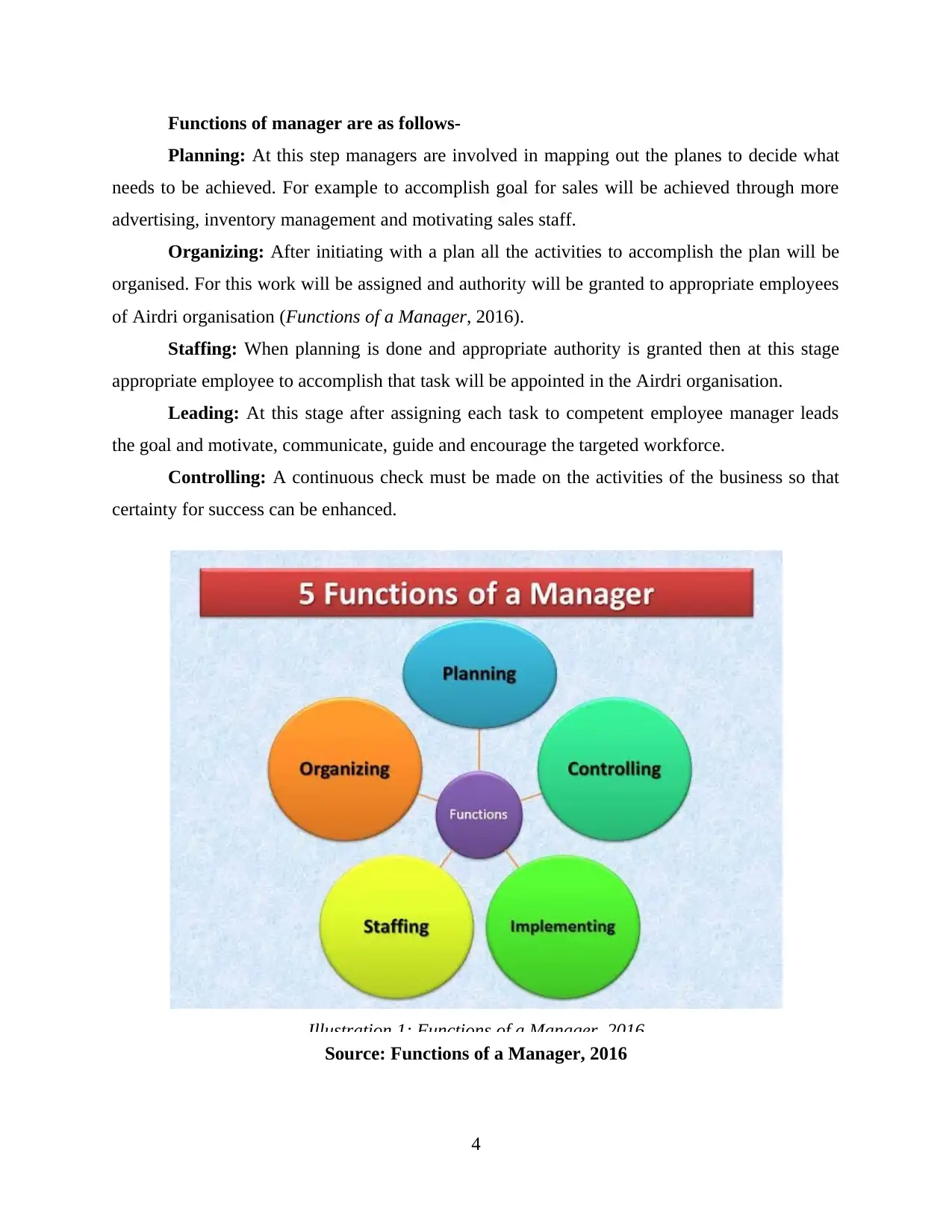
Functions of manager are as follows-
Planning: At this step managers are involved in mapping out the planes to decide what
needs to be achieved. For example to accomplish goal for sales will be achieved through more
advertising, inventory management and motivating sales staff.
Organizing: After initiating with a plan all the activities to accomplish the plan will be
organised. For this work will be assigned and authority will be granted to appropriate employees
of Airdri organisation (Functions of a Manager, 2016).
Staffing: When planning is done and appropriate authority is granted then at this stage
appropriate employee to accomplish that task will be appointed in the Airdri organisation.
Leading: At this stage after assigning each task to competent employee manager leads
the goal and motivate, communicate, guide and encourage the targeted workforce.
Controlling: A continuous check must be made on the activities of the business so that
certainty for success can be enhanced.
Source: Functions of a Manager, 2016
4
Illustration 1: Functions of a Manager, 2016
Planning: At this step managers are involved in mapping out the planes to decide what
needs to be achieved. For example to accomplish goal for sales will be achieved through more
advertising, inventory management and motivating sales staff.
Organizing: After initiating with a plan all the activities to accomplish the plan will be
organised. For this work will be assigned and authority will be granted to appropriate employees
of Airdri organisation (Functions of a Manager, 2016).
Staffing: When planning is done and appropriate authority is granted then at this stage
appropriate employee to accomplish that task will be appointed in the Airdri organisation.
Leading: At this stage after assigning each task to competent employee manager leads
the goal and motivate, communicate, guide and encourage the targeted workforce.
Controlling: A continuous check must be made on the activities of the business so that
certainty for success can be enhanced.
Source: Functions of a Manager, 2016
4
Illustration 1: Functions of a Manager, 2016
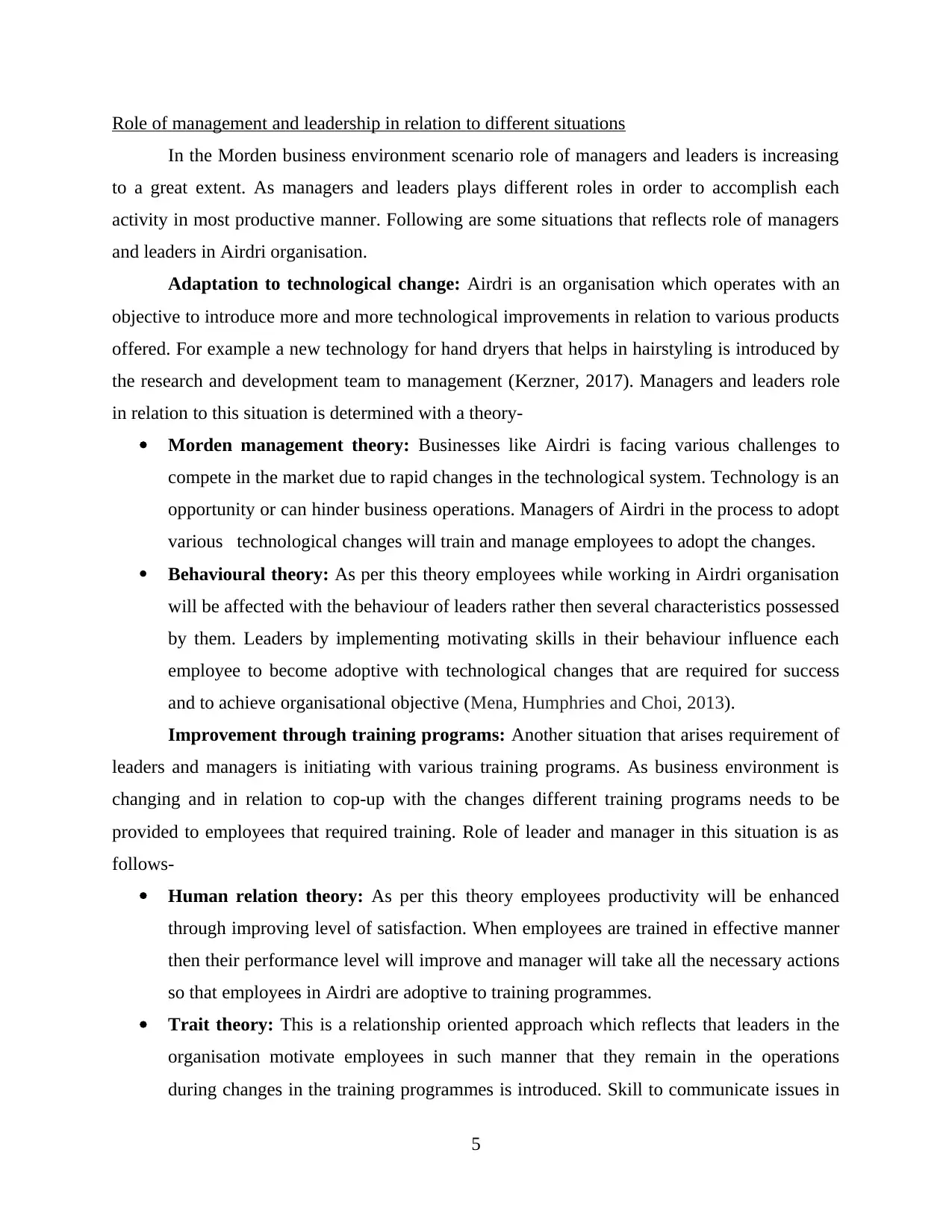
Role of management and leadership in relation to different situations
In the Morden business environment scenario role of managers and leaders is increasing
to a great extent. As managers and leaders plays different roles in order to accomplish each
activity in most productive manner. Following are some situations that reflects role of managers
and leaders in Airdri organisation.
Adaptation to technological change: Airdri is an organisation which operates with an
objective to introduce more and more technological improvements in relation to various products
offered. For example a new technology for hand dryers that helps in hairstyling is introduced by
the research and development team to management (Kerzner, 2017). Managers and leaders role
in relation to this situation is determined with a theory-
Morden management theory: Businesses like Airdri is facing various challenges to
compete in the market due to rapid changes in the technological system. Technology is an
opportunity or can hinder business operations. Managers of Airdri in the process to adopt
various technological changes will train and manage employees to adopt the changes.
Behavioural theory: As per this theory employees while working in Airdri organisation
will be affected with the behaviour of leaders rather then several characteristics possessed
by them. Leaders by implementing motivating skills in their behaviour influence each
employee to become adoptive with technological changes that are required for success
and to achieve organisational objective (Mena, Humphries and Choi, 2013).
Improvement through training programs: Another situation that arises requirement of
leaders and managers is initiating with various training programs. As business environment is
changing and in relation to cop-up with the changes different training programs needs to be
provided to employees that required training. Role of leader and manager in this situation is as
follows-
Human relation theory: As per this theory employees productivity will be enhanced
through improving level of satisfaction. When employees are trained in effective manner
then their performance level will improve and manager will take all the necessary actions
so that employees in Airdri are adoptive to training programmes.
Trait theory: This is a relationship oriented approach which reflects that leaders in the
organisation motivate employees in such manner that they remain in the operations
during changes in the training programmes is introduced. Skill to communicate issues in
5
In the Morden business environment scenario role of managers and leaders is increasing
to a great extent. As managers and leaders plays different roles in order to accomplish each
activity in most productive manner. Following are some situations that reflects role of managers
and leaders in Airdri organisation.
Adaptation to technological change: Airdri is an organisation which operates with an
objective to introduce more and more technological improvements in relation to various products
offered. For example a new technology for hand dryers that helps in hairstyling is introduced by
the research and development team to management (Kerzner, 2017). Managers and leaders role
in relation to this situation is determined with a theory-
Morden management theory: Businesses like Airdri is facing various challenges to
compete in the market due to rapid changes in the technological system. Technology is an
opportunity or can hinder business operations. Managers of Airdri in the process to adopt
various technological changes will train and manage employees to adopt the changes.
Behavioural theory: As per this theory employees while working in Airdri organisation
will be affected with the behaviour of leaders rather then several characteristics possessed
by them. Leaders by implementing motivating skills in their behaviour influence each
employee to become adoptive with technological changes that are required for success
and to achieve organisational objective (Mena, Humphries and Choi, 2013).
Improvement through training programs: Another situation that arises requirement of
leaders and managers is initiating with various training programs. As business environment is
changing and in relation to cop-up with the changes different training programs needs to be
provided to employees that required training. Role of leader and manager in this situation is as
follows-
Human relation theory: As per this theory employees productivity will be enhanced
through improving level of satisfaction. When employees are trained in effective manner
then their performance level will improve and manager will take all the necessary actions
so that employees in Airdri are adoptive to training programmes.
Trait theory: This is a relationship oriented approach which reflects that leaders in the
organisation motivate employees in such manner that they remain in the operations
during changes in the training programmes is introduced. Skill to communicate issues in
5
Paraphrase This Document
Need a fresh take? Get an instant paraphrase of this document with our AI Paraphraser

relation to particular training and changes must be developed to minimise hindrance in
the training programmes.
Situational leadership theory: As per this theory a manager and leader can react in
number of ways to a particular situation. Here a situation is for providing training to
employees in organisation for enhancing their productivity and making them adaptive to
changing environment (Ostadrahimi, Mariño and Afshar, 2012). Technique that will be
used by managers and leaders will depend on the complexity involved in a particular
situation. A theory that will help employees to involve more and more in training
programs and tacking changes in positive manner will be considered to be implemented
in business organisation.
Strengths and Weaknesses to different approaches of leadership
Situational leadership theory:
Strengths
It will provide flexibility among managers and leaders to take decision for various
organisational issues.
Helps superiors to create a positive and motivating business environment based on
situation for their subordinates.
Weaknesses
This theory provides solutions for immediate needs rather then long term solutions.
Flexibility in each situation some times hinders performance of business as no support is
received to flexible decisions.
Trait theory:
Strengths
Trait theory relies on statistical data and this makes all the decision more viable accurate.
Decisions taken through trait theory are not biased (Saud, Israni and Goddard, 2014).
Weaknesses
Future can not be predicted in actual numbers and personality changes are not accounted
in trait theory.
This theory does not reflect how positive traits can be used and negative traits can be
minimised.
Behavioural Theory:
6
the training programmes.
Situational leadership theory: As per this theory a manager and leader can react in
number of ways to a particular situation. Here a situation is for providing training to
employees in organisation for enhancing their productivity and making them adaptive to
changing environment (Ostadrahimi, Mariño and Afshar, 2012). Technique that will be
used by managers and leaders will depend on the complexity involved in a particular
situation. A theory that will help employees to involve more and more in training
programs and tacking changes in positive manner will be considered to be implemented
in business organisation.
Strengths and Weaknesses to different approaches of leadership
Situational leadership theory:
Strengths
It will provide flexibility among managers and leaders to take decision for various
organisational issues.
Helps superiors to create a positive and motivating business environment based on
situation for their subordinates.
Weaknesses
This theory provides solutions for immediate needs rather then long term solutions.
Flexibility in each situation some times hinders performance of business as no support is
received to flexible decisions.
Trait theory:
Strengths
Trait theory relies on statistical data and this makes all the decision more viable accurate.
Decisions taken through trait theory are not biased (Saud, Israni and Goddard, 2014).
Weaknesses
Future can not be predicted in actual numbers and personality changes are not accounted
in trait theory.
This theory does not reflect how positive traits can be used and negative traits can be
minimised.
Behavioural Theory:
6

Strengths
This theory supports the idea that leadership can be learned through experience and
development.
New leadership theory is supported to be used in leadership to produce intended results.
Weaknesses
With learning people can not enact leadership in more appropriate manner.
Their is lack of knowledge on how behaviour theory is used in cultural contact and
situation when applied to an organisation (Song and Panayides, 2012).
Application of “Chaos theory” and “Management by objective” to Airdri organisation
Chaos theory helps to deal with certain systems that are very sensitive in relation to an
activity. A very small change may make the system to behave completely different. As per this
theory it is curtained that no organisation can completely minimise the effect caused with
seemingly random events. Plans that are established by each business organisation helps in
achieving business objectives when they are established for short duration. A long term future
prediction is not enough in order to attain goals and objectives. As per Chaos theory short term
future forecasts are more certain as chances for change in the basis of prediction is high when
decisions are accessed in long run. This theory will be applied in Airdri business organisation
through leadership. As Chaos theory shows the need for effective leadership for guiding, vision,
strong values, organisational beliefs and open communication. Products that are served by Airdri
organisation is highly technological and a small change in the technology make huge difference
in the organisation success (Spilý, 2014). Through Chaos theory Airdri organisation will make
plans that are related to short run and changes will be adopted when takes place in long run.
Management by Objective is an strategic management model that aims to improve
performance of an organisation by clearly defining goals and objective that needs to be achieved
with management and employees coordination. It is a result oriented process that focuses on
setting and controlling goals that needs to be achieved. In this process managers are involved as
planners and a detailed plan specifying each task in complete manner is provided in this model.
Important task to achieve a particular task is provided concentration by reducing cost and
providing more and more opportunities.
In the process of introducing technological changes in Airdri organisation using
management by operations goals and objective that needs to be achieved will be elaborated. In
7
This theory supports the idea that leadership can be learned through experience and
development.
New leadership theory is supported to be used in leadership to produce intended results.
Weaknesses
With learning people can not enact leadership in more appropriate manner.
Their is lack of knowledge on how behaviour theory is used in cultural contact and
situation when applied to an organisation (Song and Panayides, 2012).
Application of “Chaos theory” and “Management by objective” to Airdri organisation
Chaos theory helps to deal with certain systems that are very sensitive in relation to an
activity. A very small change may make the system to behave completely different. As per this
theory it is curtained that no organisation can completely minimise the effect caused with
seemingly random events. Plans that are established by each business organisation helps in
achieving business objectives when they are established for short duration. A long term future
prediction is not enough in order to attain goals and objectives. As per Chaos theory short term
future forecasts are more certain as chances for change in the basis of prediction is high when
decisions are accessed in long run. This theory will be applied in Airdri business organisation
through leadership. As Chaos theory shows the need for effective leadership for guiding, vision,
strong values, organisational beliefs and open communication. Products that are served by Airdri
organisation is highly technological and a small change in the technology make huge difference
in the organisation success (Spilý, 2014). Through Chaos theory Airdri organisation will make
plans that are related to short run and changes will be adopted when takes place in long run.
Management by Objective is an strategic management model that aims to improve
performance of an organisation by clearly defining goals and objective that needs to be achieved
with management and employees coordination. It is a result oriented process that focuses on
setting and controlling goals that needs to be achieved. In this process managers are involved as
planners and a detailed plan specifying each task in complete manner is provided in this model.
Important task to achieve a particular task is provided concentration by reducing cost and
providing more and more opportunities.
In the process of introducing technological changes in Airdri organisation using
management by operations goals and objective that needs to be achieved will be elaborated. In
7
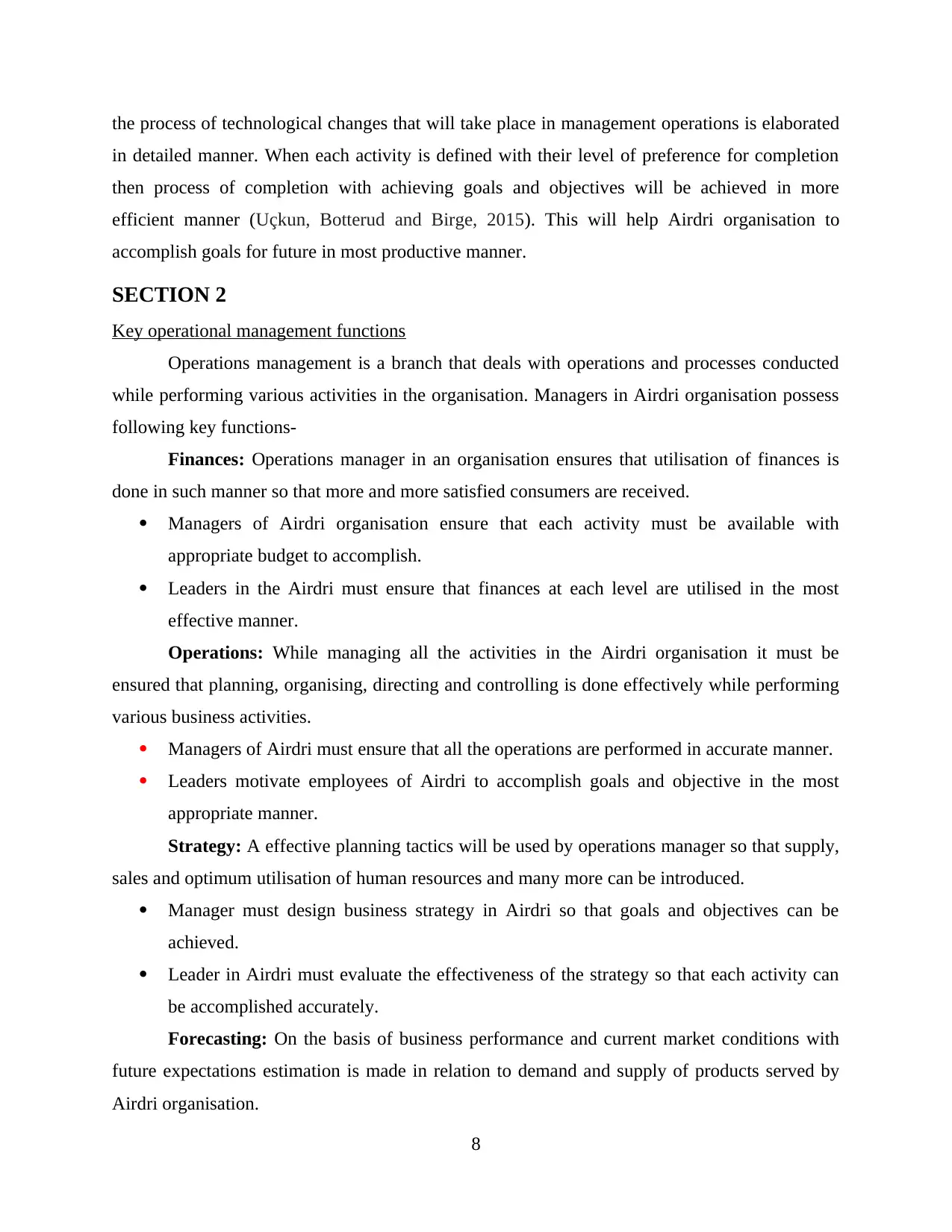
the process of technological changes that will take place in management operations is elaborated
in detailed manner. When each activity is defined with their level of preference for completion
then process of completion with achieving goals and objectives will be achieved in more
efficient manner (Uçkun, Botterud and Birge, 2015). This will help Airdri organisation to
accomplish goals for future in most productive manner.
SECTION 2
Key operational management functions
Operations management is a branch that deals with operations and processes conducted
while performing various activities in the organisation. Managers in Airdri organisation possess
following key functions-
Finances: Operations manager in an organisation ensures that utilisation of finances is
done in such manner so that more and more satisfied consumers are received.
Managers of Airdri organisation ensure that each activity must be available with
appropriate budget to accomplish.
Leaders in the Airdri must ensure that finances at each level are utilised in the most
effective manner.
Operations: While managing all the activities in the Airdri organisation it must be
ensured that planning, organising, directing and controlling is done effectively while performing
various business activities.
Managers of Airdri must ensure that all the operations are performed in accurate manner.
Leaders motivate employees of Airdri to accomplish goals and objective in the most
appropriate manner.
Strategy: A effective planning tactics will be used by operations manager so that supply,
sales and optimum utilisation of human resources and many more can be introduced.
Manager must design business strategy in Airdri so that goals and objectives can be
achieved.
Leader in Airdri must evaluate the effectiveness of the strategy so that each activity can
be accomplished accurately.
Forecasting: On the basis of business performance and current market conditions with
future expectations estimation is made in relation to demand and supply of products served by
Airdri organisation.
8
in detailed manner. When each activity is defined with their level of preference for completion
then process of completion with achieving goals and objectives will be achieved in more
efficient manner (Uçkun, Botterud and Birge, 2015). This will help Airdri organisation to
accomplish goals for future in most productive manner.
SECTION 2
Key operational management functions
Operations management is a branch that deals with operations and processes conducted
while performing various activities in the organisation. Managers in Airdri organisation possess
following key functions-
Finances: Operations manager in an organisation ensures that utilisation of finances is
done in such manner so that more and more satisfied consumers are received.
Managers of Airdri organisation ensure that each activity must be available with
appropriate budget to accomplish.
Leaders in the Airdri must ensure that finances at each level are utilised in the most
effective manner.
Operations: While managing all the activities in the Airdri organisation it must be
ensured that planning, organising, directing and controlling is done effectively while performing
various business activities.
Managers of Airdri must ensure that all the operations are performed in accurate manner.
Leaders motivate employees of Airdri to accomplish goals and objective in the most
appropriate manner.
Strategy: A effective planning tactics will be used by operations manager so that supply,
sales and optimum utilisation of human resources and many more can be introduced.
Manager must design business strategy in Airdri so that goals and objectives can be
achieved.
Leader in Airdri must evaluate the effectiveness of the strategy so that each activity can
be accomplished accurately.
Forecasting: On the basis of business performance and current market conditions with
future expectations estimation is made in relation to demand and supply of products served by
Airdri organisation.
8
Secure Best Marks with AI Grader
Need help grading? Try our AI Grader for instant feedback on your assignments.

Mangers must forecast on the basis of present performances and future expectations from
employees in Airdri.
Leaders supports business organisation to accomplish all the requirements to perform on
the plans designed on forecasted basis.
Key approaches of operations management
There are few common method that are part of management and operation that enables manager
to reach desired objective to increase efficiency of business. In Airdri, manager applies some
main approaches that can bring skilfulness and improve attribute of goods. This also let them to
save costs and use each resource in respective manner to gain profitability.
Lean manufacturing: It is a technique which can enable Airdri improve efficiency and
achieve maximum efficiency of development activities (Zabalza and Matey, 2012). This is a
process that takes into account the concept of reducing waste and steadily increasing business
activity efficiency. The Lean production as it involves organization's output role and also has
five concepts is a further title of this methods: Consumers prospective- Quality in this case means investors ' willingness to reimburse
for their goods. Value is produced by business and supplied by customers in accordance
with their specifications and requirements. Airdri managers can eliminate goods that their
intended audience does not require and work on more needed products. In many other
waste reduction activities they can therefore use these resources. Map the value stream- The idea is reflected in the way to generating value in order to
know much more about necessary resources by the organization. Managers of respective
firm will determine and see how assets are needed to manufacture goods that the
customer requires and is expected to pay for these goods. Build flow- This idea has to do with the smooth operation within company. Now
management attempts to create an efficient stream of the Airdri activities while removing
the excess and defining interest. This movement contributes to harmonization of
company culture and is very good for the development of businesses (Grant, Trautrims
and Wong, 2017). Develop Pull system- The method is guided by just-in-time theory, which states that when
firms submit shipments, manufactured goods and other products should be gathered.
According to a pushing system the method is reliable and cost-effective.
9
employees in Airdri.
Leaders supports business organisation to accomplish all the requirements to perform on
the plans designed on forecasted basis.
Key approaches of operations management
There are few common method that are part of management and operation that enables manager
to reach desired objective to increase efficiency of business. In Airdri, manager applies some
main approaches that can bring skilfulness and improve attribute of goods. This also let them to
save costs and use each resource in respective manner to gain profitability.
Lean manufacturing: It is a technique which can enable Airdri improve efficiency and
achieve maximum efficiency of development activities (Zabalza and Matey, 2012). This is a
process that takes into account the concept of reducing waste and steadily increasing business
activity efficiency. The Lean production as it involves organization's output role and also has
five concepts is a further title of this methods: Consumers prospective- Quality in this case means investors ' willingness to reimburse
for their goods. Value is produced by business and supplied by customers in accordance
with their specifications and requirements. Airdri managers can eliminate goods that their
intended audience does not require and work on more needed products. In many other
waste reduction activities they can therefore use these resources. Map the value stream- The idea is reflected in the way to generating value in order to
know much more about necessary resources by the organization. Managers of respective
firm will determine and see how assets are needed to manufacture goods that the
customer requires and is expected to pay for these goods. Build flow- This idea has to do with the smooth operation within company. Now
management attempts to create an efficient stream of the Airdri activities while removing
the excess and defining interest. This movement contributes to harmonization of
company culture and is very good for the development of businesses (Grant, Trautrims
and Wong, 2017). Develop Pull system- The method is guided by just-in-time theory, which states that when
firms submit shipments, manufactured goods and other products should be gathered.
According to a pushing system the method is reliable and cost-effective.
9
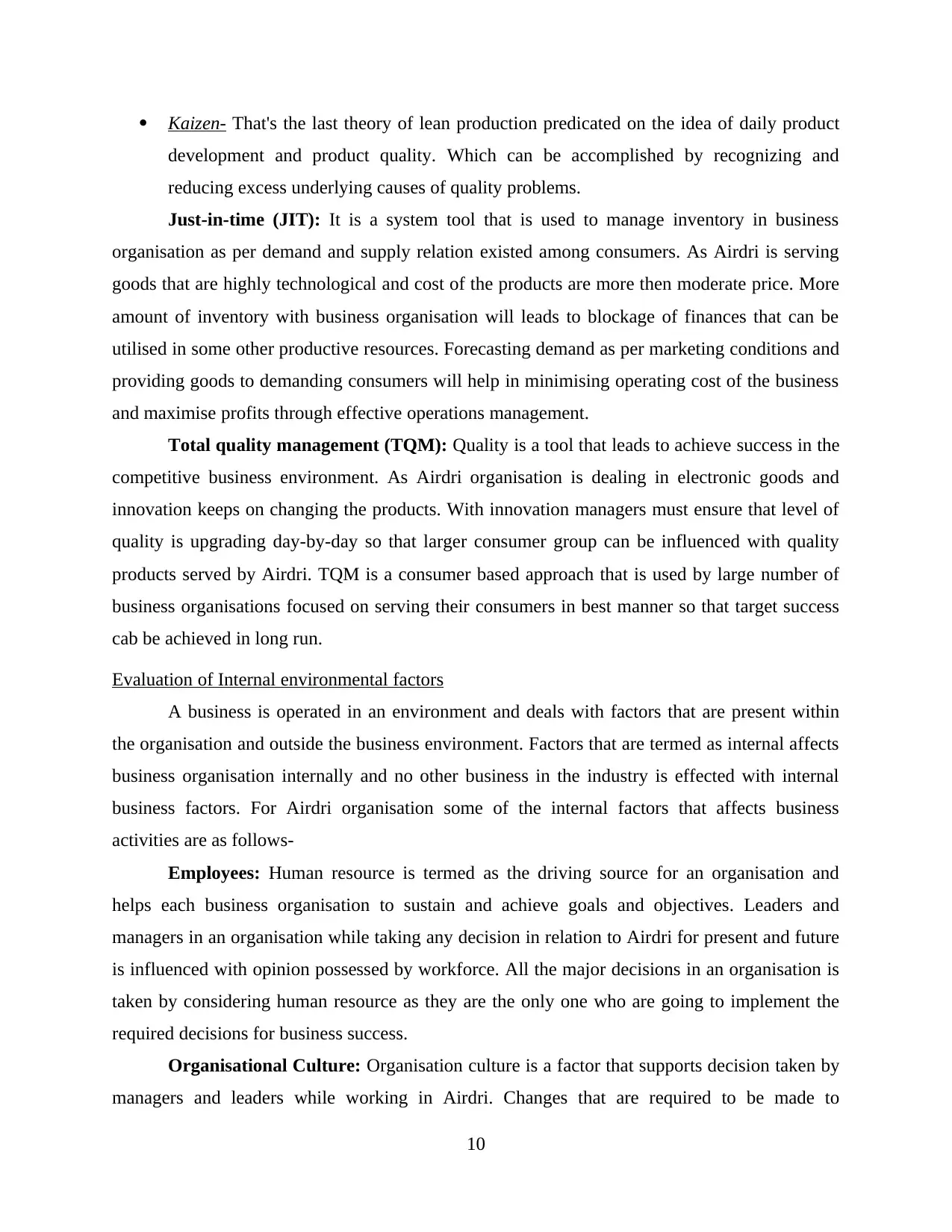
Kaizen- That's the last theory of lean production predicated on the idea of daily product
development and product quality. Which can be accomplished by recognizing and
reducing excess underlying causes of quality problems.
Just-in-time (JIT): It is a system tool that is used to manage inventory in business
organisation as per demand and supply relation existed among consumers. As Airdri is serving
goods that are highly technological and cost of the products are more then moderate price. More
amount of inventory with business organisation will leads to blockage of finances that can be
utilised in some other productive resources. Forecasting demand as per marketing conditions and
providing goods to demanding consumers will help in minimising operating cost of the business
and maximise profits through effective operations management.
Total quality management (TQM): Quality is a tool that leads to achieve success in the
competitive business environment. As Airdri organisation is dealing in electronic goods and
innovation keeps on changing the products. With innovation managers must ensure that level of
quality is upgrading day-by-day so that larger consumer group can be influenced with quality
products served by Airdri. TQM is a consumer based approach that is used by large number of
business organisations focused on serving their consumers in best manner so that target success
cab be achieved in long run.
Evaluation of Internal environmental factors
A business is operated in an environment and deals with factors that are present within
the organisation and outside the business environment. Factors that are termed as internal affects
business organisation internally and no other business in the industry is effected with internal
business factors. For Airdri organisation some of the internal factors that affects business
activities are as follows-
Employees: Human resource is termed as the driving source for an organisation and
helps each business organisation to sustain and achieve goals and objectives. Leaders and
managers in an organisation while taking any decision in relation to Airdri for present and future
is influenced with opinion possessed by workforce. All the major decisions in an organisation is
taken by considering human resource as they are the only one who are going to implement the
required decisions for business success.
Organisational Culture: Organisation culture is a factor that supports decision taken by
managers and leaders while working in Airdri. Changes that are required to be made to
10
development and product quality. Which can be accomplished by recognizing and
reducing excess underlying causes of quality problems.
Just-in-time (JIT): It is a system tool that is used to manage inventory in business
organisation as per demand and supply relation existed among consumers. As Airdri is serving
goods that are highly technological and cost of the products are more then moderate price. More
amount of inventory with business organisation will leads to blockage of finances that can be
utilised in some other productive resources. Forecasting demand as per marketing conditions and
providing goods to demanding consumers will help in minimising operating cost of the business
and maximise profits through effective operations management.
Total quality management (TQM): Quality is a tool that leads to achieve success in the
competitive business environment. As Airdri organisation is dealing in electronic goods and
innovation keeps on changing the products. With innovation managers must ensure that level of
quality is upgrading day-by-day so that larger consumer group can be influenced with quality
products served by Airdri. TQM is a consumer based approach that is used by large number of
business organisations focused on serving their consumers in best manner so that target success
cab be achieved in long run.
Evaluation of Internal environmental factors
A business is operated in an environment and deals with factors that are present within
the organisation and outside the business environment. Factors that are termed as internal affects
business organisation internally and no other business in the industry is effected with internal
business factors. For Airdri organisation some of the internal factors that affects business
activities are as follows-
Employees: Human resource is termed as the driving source for an organisation and
helps each business organisation to sustain and achieve goals and objectives. Leaders and
managers in an organisation while taking any decision in relation to Airdri for present and future
is influenced with opinion possessed by workforce. All the major decisions in an organisation is
taken by considering human resource as they are the only one who are going to implement the
required decisions for business success.
Organisational Culture: Organisation culture is a factor that supports decision taken by
managers and leaders while working in Airdri. Changes that are required to be made to
10

implement improved technology must get adopted thorough organisation culture. Managers and
leaders while taking a business decision must consider organisational culture so that application
can be made more effectively.
Evaluation of External environmental factors
External environmental factors are those that affects operations of all the organisation
operating in the industry. Factors that affects Airdri organisation are as follows-
Political: These factors are based on rules and regulations made by government in
relation to business organisation specially deals in electronic products. BREXIT is one of the
recent change in the political stability in UK that leads managers and leaders of Airdri to find
ways to cop-up with changes (Zharov, 2019).
Economic: These factors possess positive and negative impact on the performance of an
business organisation. Economic factors such as foreign exchange rate, employment rate and
fluctuation in the cost of raw material may impact performance of all the organisation competing
with Airdri.
Social: This factor helps in identifying emerging trends in the business environment and
helps in satisfying consumers with their needs and wants. Current trends, education level and
adaptation to lifestyle change is a tool that helps Airdri organisation to introduce changes in the
product offered.
Technological: As Airdri organisation deals in electronic industry and technological
development and innovation keeps on changing the business environment and competition
available their in. together with adaptation to changes in digital technology new methods of
distribution and manufacturing must be adopted to become more and more competent.
Improvement of operational efficiency in managers and leaders
There are number of methods that are adopted by managers and leaders in Airdri
organisation in process to improve operational efficiency. Some of the methods for improvement
are as follows-
Methods for leaders to improving operational efficiency-
Leaders can use motivational tool in such manner so that employees operating at different
level in Airdri operates with greatest efficiency and achieve the required goals and
objectives.
11
leaders while taking a business decision must consider organisational culture so that application
can be made more effectively.
Evaluation of External environmental factors
External environmental factors are those that affects operations of all the organisation
operating in the industry. Factors that affects Airdri organisation are as follows-
Political: These factors are based on rules and regulations made by government in
relation to business organisation specially deals in electronic products. BREXIT is one of the
recent change in the political stability in UK that leads managers and leaders of Airdri to find
ways to cop-up with changes (Zharov, 2019).
Economic: These factors possess positive and negative impact on the performance of an
business organisation. Economic factors such as foreign exchange rate, employment rate and
fluctuation in the cost of raw material may impact performance of all the organisation competing
with Airdri.
Social: This factor helps in identifying emerging trends in the business environment and
helps in satisfying consumers with their needs and wants. Current trends, education level and
adaptation to lifestyle change is a tool that helps Airdri organisation to introduce changes in the
product offered.
Technological: As Airdri organisation deals in electronic industry and technological
development and innovation keeps on changing the business environment and competition
available their in. together with adaptation to changes in digital technology new methods of
distribution and manufacturing must be adopted to become more and more competent.
Improvement of operational efficiency in managers and leaders
There are number of methods that are adopted by managers and leaders in Airdri
organisation in process to improve operational efficiency. Some of the methods for improvement
are as follows-
Methods for leaders to improving operational efficiency-
Leaders can use motivational tool in such manner so that employees operating at different
level in Airdri operates with greatest efficiency and achieve the required goals and
objectives.
11
Paraphrase This Document
Need a fresh take? Get an instant paraphrase of this document with our AI Paraphraser
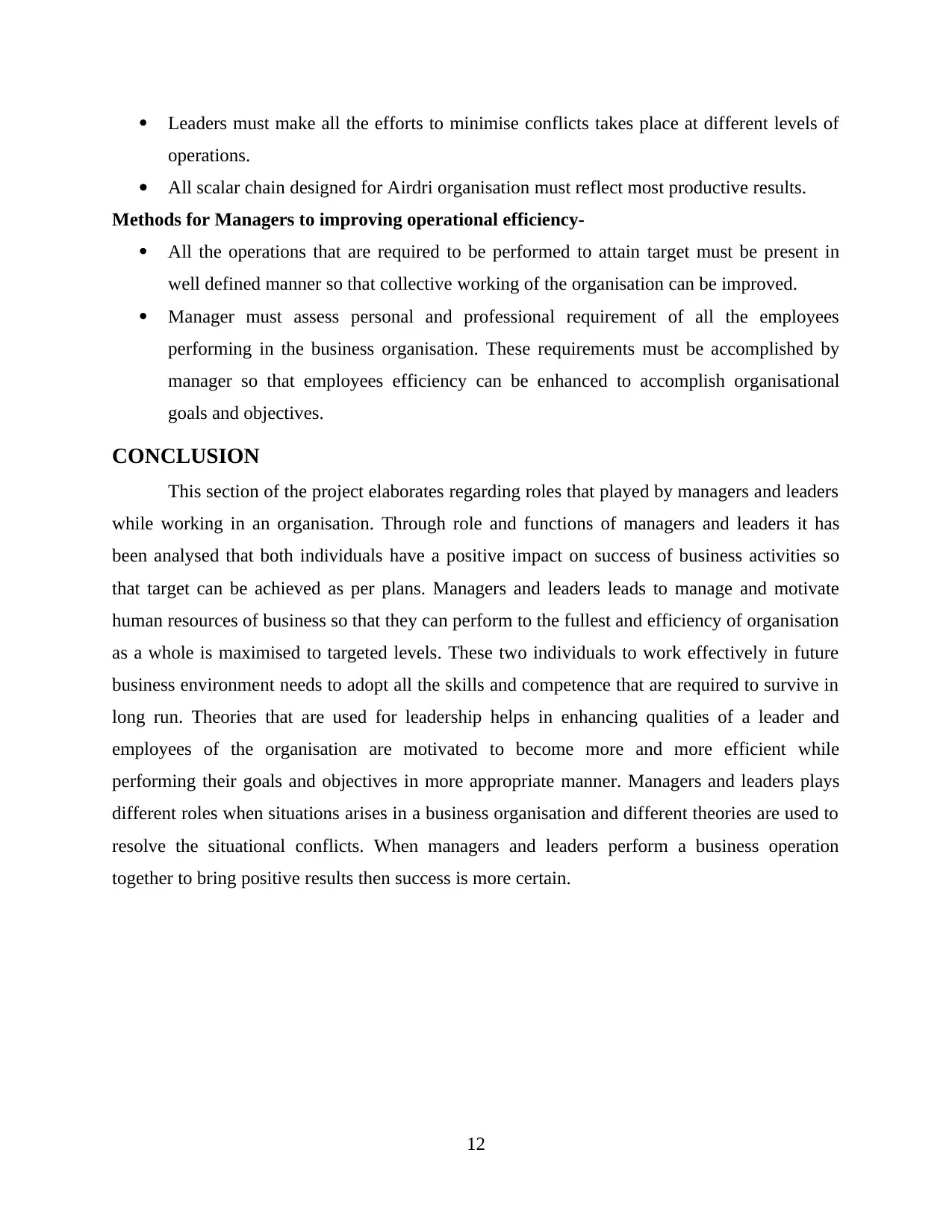
Leaders must make all the efforts to minimise conflicts takes place at different levels of
operations.
All scalar chain designed for Airdri organisation must reflect most productive results.
Methods for Managers to improving operational efficiency-
All the operations that are required to be performed to attain target must be present in
well defined manner so that collective working of the organisation can be improved.
Manager must assess personal and professional requirement of all the employees
performing in the business organisation. These requirements must be accomplished by
manager so that employees efficiency can be enhanced to accomplish organisational
goals and objectives.
CONCLUSION
This section of the project elaborates regarding roles that played by managers and leaders
while working in an organisation. Through role and functions of managers and leaders it has
been analysed that both individuals have a positive impact on success of business activities so
that target can be achieved as per plans. Managers and leaders leads to manage and motivate
human resources of business so that they can perform to the fullest and efficiency of organisation
as a whole is maximised to targeted levels. These two individuals to work effectively in future
business environment needs to adopt all the skills and competence that are required to survive in
long run. Theories that are used for leadership helps in enhancing qualities of a leader and
employees of the organisation are motivated to become more and more efficient while
performing their goals and objectives in more appropriate manner. Managers and leaders plays
different roles when situations arises in a business organisation and different theories are used to
resolve the situational conflicts. When managers and leaders perform a business operation
together to bring positive results then success is more certain.
12
operations.
All scalar chain designed for Airdri organisation must reflect most productive results.
Methods for Managers to improving operational efficiency-
All the operations that are required to be performed to attain target must be present in
well defined manner so that collective working of the organisation can be improved.
Manager must assess personal and professional requirement of all the employees
performing in the business organisation. These requirements must be accomplished by
manager so that employees efficiency can be enhanced to accomplish organisational
goals and objectives.
CONCLUSION
This section of the project elaborates regarding roles that played by managers and leaders
while working in an organisation. Through role and functions of managers and leaders it has
been analysed that both individuals have a positive impact on success of business activities so
that target can be achieved as per plans. Managers and leaders leads to manage and motivate
human resources of business so that they can perform to the fullest and efficiency of organisation
as a whole is maximised to targeted levels. These two individuals to work effectively in future
business environment needs to adopt all the skills and competence that are required to survive in
long run. Theories that are used for leadership helps in enhancing qualities of a leader and
employees of the organisation are motivated to become more and more efficient while
performing their goals and objectives in more appropriate manner. Managers and leaders plays
different roles when situations arises in a business organisation and different theories are used to
resolve the situational conflicts. When managers and leaders perform a business operation
together to bring positive results then success is more certain.
12
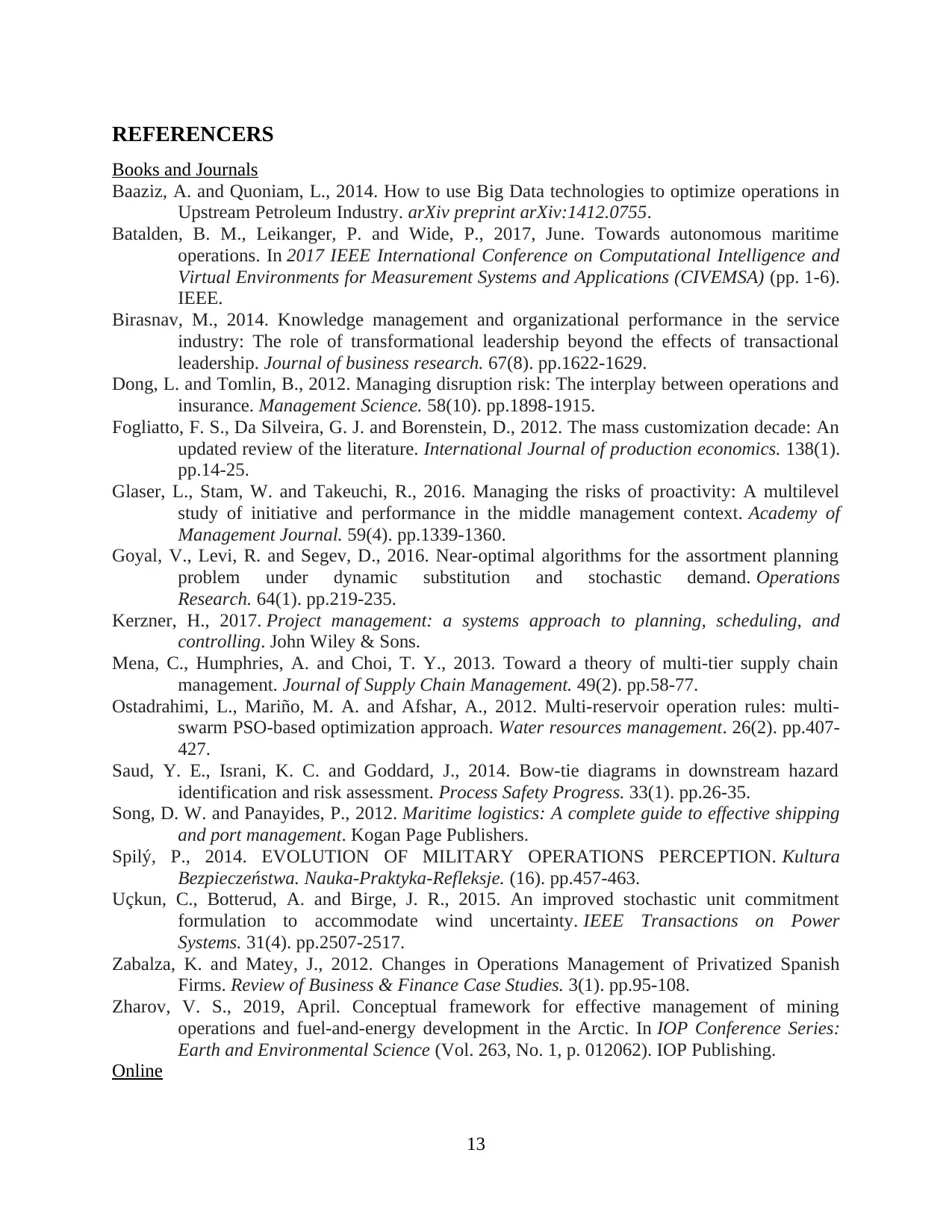
REFERENCERS
Books and Journals
Baaziz, A. and Quoniam, L., 2014. How to use Big Data technologies to optimize operations in
Upstream Petroleum Industry. arXiv preprint arXiv:1412.0755.
Batalden, B. M., Leikanger, P. and Wide, P., 2017, June. Towards autonomous maritime
operations. In 2017 IEEE International Conference on Computational Intelligence and
Virtual Environments for Measurement Systems and Applications (CIVEMSA) (pp. 1-6).
IEEE.
Birasnav, M., 2014. Knowledge management and organizational performance in the service
industry: The role of transformational leadership beyond the effects of transactional
leadership. Journal of business research. 67(8). pp.1622-1629.
Dong, L. and Tomlin, B., 2012. Managing disruption risk: The interplay between operations and
insurance. Management Science. 58(10). pp.1898-1915.
Fogliatto, F. S., Da Silveira, G. J. and Borenstein, D., 2012. The mass customization decade: An
updated review of the literature. International Journal of production economics. 138(1).
pp.14-25.
Glaser, L., Stam, W. and Takeuchi, R., 2016. Managing the risks of proactivity: A multilevel
study of initiative and performance in the middle management context. Academy of
Management Journal. 59(4). pp.1339-1360.
Goyal, V., Levi, R. and Segev, D., 2016. Near-optimal algorithms for the assortment planning
problem under dynamic substitution and stochastic demand. Operations
Research. 64(1). pp.219-235.
Kerzner, H., 2017. Project management: a systems approach to planning, scheduling, and
controlling. John Wiley & Sons.
Mena, C., Humphries, A. and Choi, T. Y., 2013. Toward a theory of multi‐tier supply chain
management. Journal of Supply Chain Management. 49(2). pp.58-77.
Ostadrahimi, L., Mariño, M. A. and Afshar, A., 2012. Multi-reservoir operation rules: multi-
swarm PSO-based optimization approach. Water resources management. 26(2). pp.407-
427.
Saud, Y. E., Israni, K. C. and Goddard, J., 2014. Bow‐tie diagrams in downstream hazard
identification and risk assessment. Process Safety Progress. 33(1). pp.26-35.
Song, D. W. and Panayides, P., 2012. Maritime logistics: A complete guide to effective shipping
and port management. Kogan Page Publishers.
Spilý, P., 2014. EVOLUTION OF MILITARY OPERATIONS PERCEPTION. Kultura
Bezpieczeństwa. Nauka-Praktyka-Refleksje. (16). pp.457-463.
Uçkun, C., Botterud, A. and Birge, J. R., 2015. An improved stochastic unit commitment
formulation to accommodate wind uncertainty. IEEE Transactions on Power
Systems. 31(4). pp.2507-2517.
Zabalza, K. and Matey, J., 2012. Changes in Operations Management of Privatized Spanish
Firms. Review of Business & Finance Case Studies. 3(1). pp.95-108.
Zharov, V. S., 2019, April. Conceptual framework for effective management of mining
operations and fuel-and-energy development in the Arctic. In IOP Conference Series:
Earth and Environmental Science (Vol. 263, No. 1, p. 012062). IOP Publishing.
Online
13
Books and Journals
Baaziz, A. and Quoniam, L., 2014. How to use Big Data technologies to optimize operations in
Upstream Petroleum Industry. arXiv preprint arXiv:1412.0755.
Batalden, B. M., Leikanger, P. and Wide, P., 2017, June. Towards autonomous maritime
operations. In 2017 IEEE International Conference on Computational Intelligence and
Virtual Environments for Measurement Systems and Applications (CIVEMSA) (pp. 1-6).
IEEE.
Birasnav, M., 2014. Knowledge management and organizational performance in the service
industry: The role of transformational leadership beyond the effects of transactional
leadership. Journal of business research. 67(8). pp.1622-1629.
Dong, L. and Tomlin, B., 2012. Managing disruption risk: The interplay between operations and
insurance. Management Science. 58(10). pp.1898-1915.
Fogliatto, F. S., Da Silveira, G. J. and Borenstein, D., 2012. The mass customization decade: An
updated review of the literature. International Journal of production economics. 138(1).
pp.14-25.
Glaser, L., Stam, W. and Takeuchi, R., 2016. Managing the risks of proactivity: A multilevel
study of initiative and performance in the middle management context. Academy of
Management Journal. 59(4). pp.1339-1360.
Goyal, V., Levi, R. and Segev, D., 2016. Near-optimal algorithms for the assortment planning
problem under dynamic substitution and stochastic demand. Operations
Research. 64(1). pp.219-235.
Kerzner, H., 2017. Project management: a systems approach to planning, scheduling, and
controlling. John Wiley & Sons.
Mena, C., Humphries, A. and Choi, T. Y., 2013. Toward a theory of multi‐tier supply chain
management. Journal of Supply Chain Management. 49(2). pp.58-77.
Ostadrahimi, L., Mariño, M. A. and Afshar, A., 2012. Multi-reservoir operation rules: multi-
swarm PSO-based optimization approach. Water resources management. 26(2). pp.407-
427.
Saud, Y. E., Israni, K. C. and Goddard, J., 2014. Bow‐tie diagrams in downstream hazard
identification and risk assessment. Process Safety Progress. 33(1). pp.26-35.
Song, D. W. and Panayides, P., 2012. Maritime logistics: A complete guide to effective shipping
and port management. Kogan Page Publishers.
Spilý, P., 2014. EVOLUTION OF MILITARY OPERATIONS PERCEPTION. Kultura
Bezpieczeństwa. Nauka-Praktyka-Refleksje. (16). pp.457-463.
Uçkun, C., Botterud, A. and Birge, J. R., 2015. An improved stochastic unit commitment
formulation to accommodate wind uncertainty. IEEE Transactions on Power
Systems. 31(4). pp.2507-2517.
Zabalza, K. and Matey, J., 2012. Changes in Operations Management of Privatized Spanish
Firms. Review of Business & Finance Case Studies. 3(1). pp.95-108.
Zharov, V. S., 2019, April. Conceptual framework for effective management of mining
operations and fuel-and-energy development in the Arctic. In IOP Conference Series:
Earth and Environmental Science (Vol. 263, No. 1, p. 012062). IOP Publishing.
Online
13
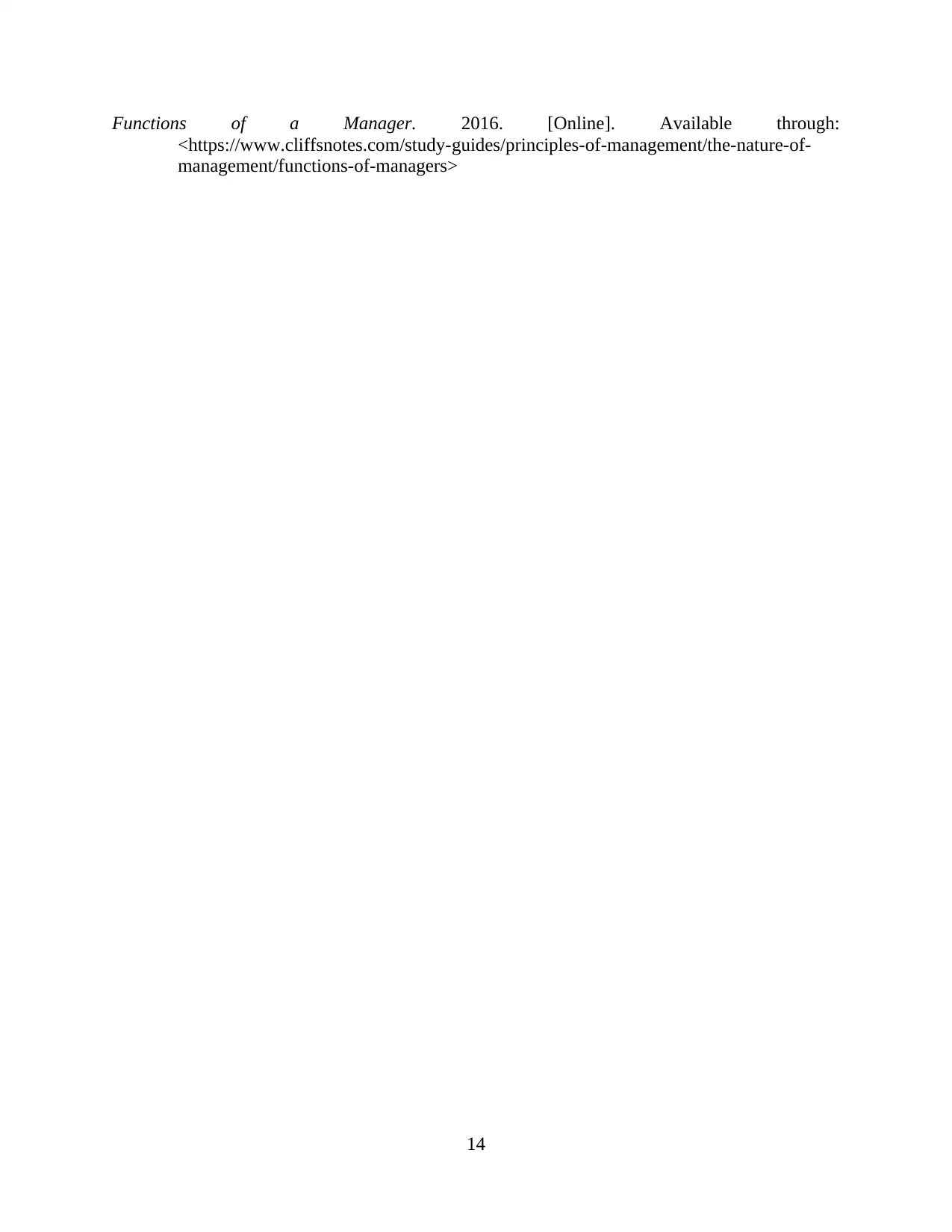
Functions of a Manager. 2016. [Online]. Available through:
<https://www.cliffsnotes.com/study-guides/principles-of-management/the-nature-of-
management/functions-of-managers>
14
<https://www.cliffsnotes.com/study-guides/principles-of-management/the-nature-of-
management/functions-of-managers>
14
1 out of 16
Related Documents
Your All-in-One AI-Powered Toolkit for Academic Success.
+13062052269
info@desklib.com
Available 24*7 on WhatsApp / Email
![[object Object]](/_next/static/media/star-bottom.7253800d.svg)
Unlock your academic potential
© 2024 | Zucol Services PVT LTD | All rights reserved.





